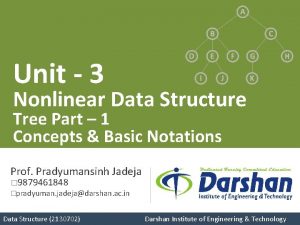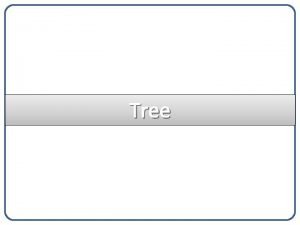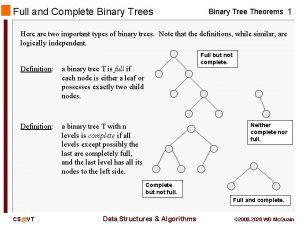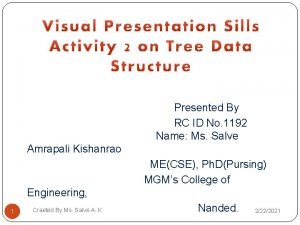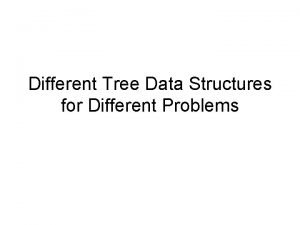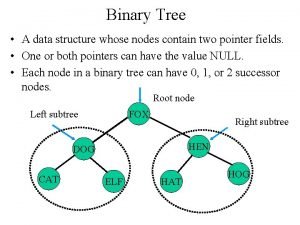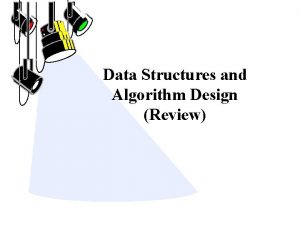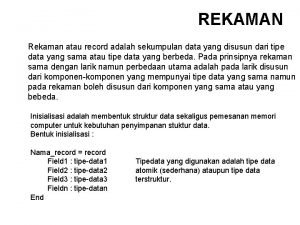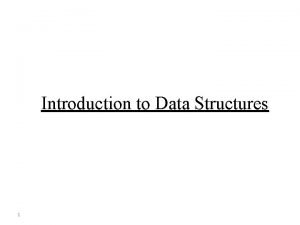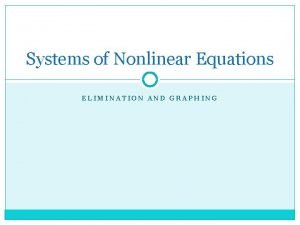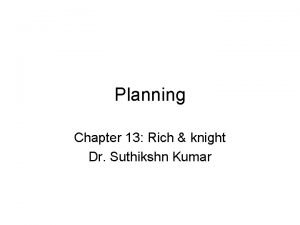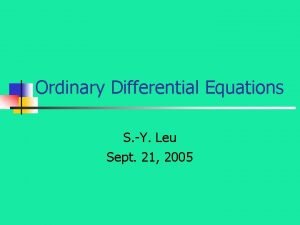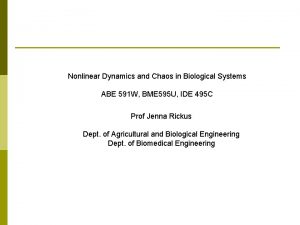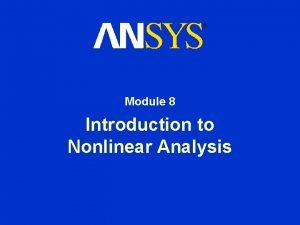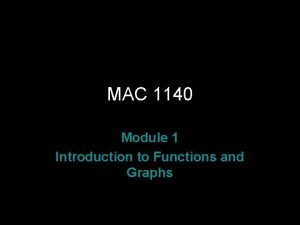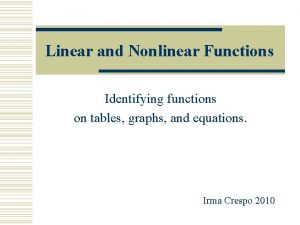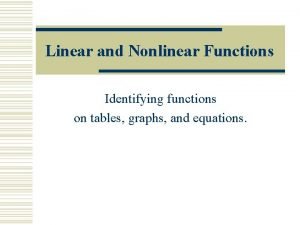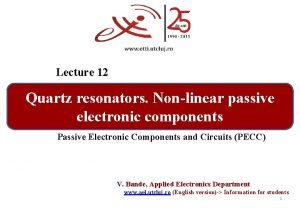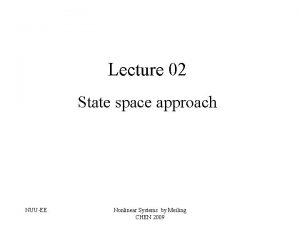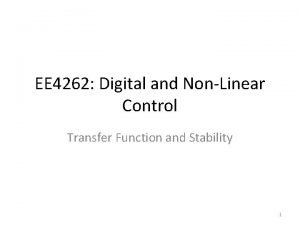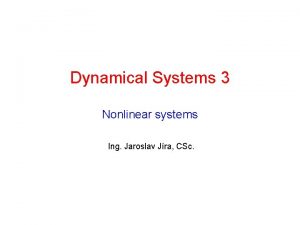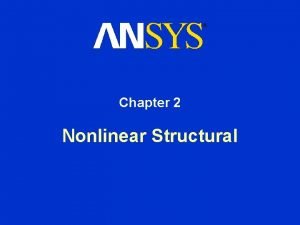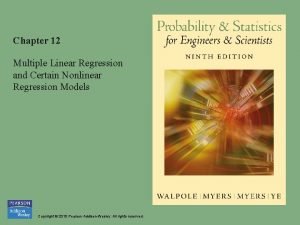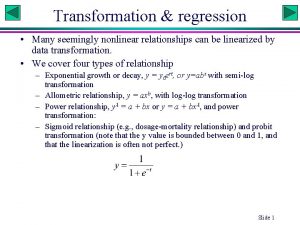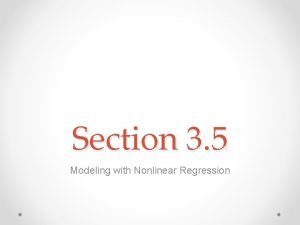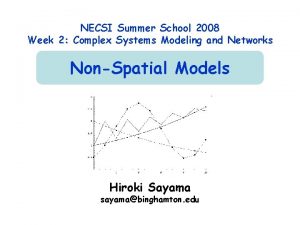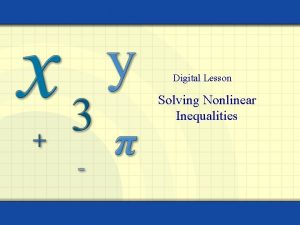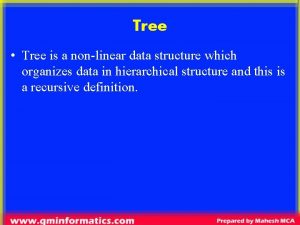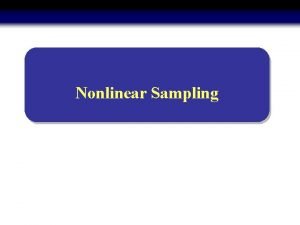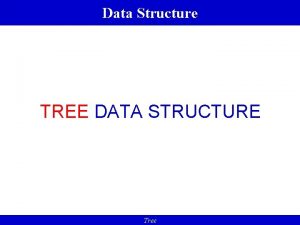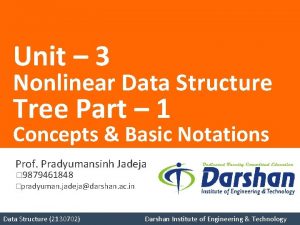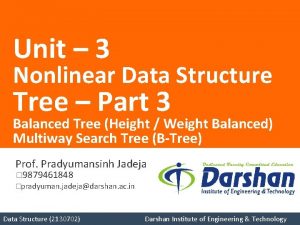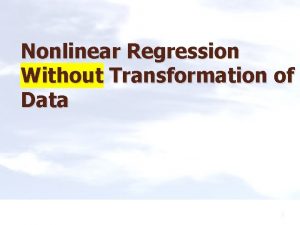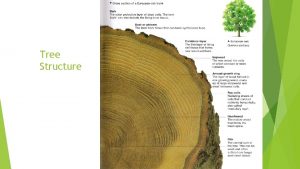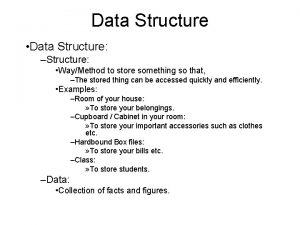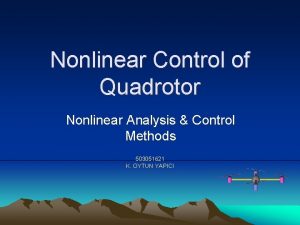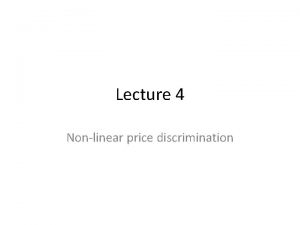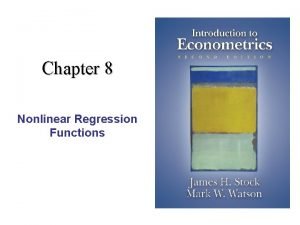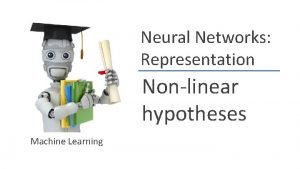Tree Data Structure A tree is a nonlinear

















![�Algorithm: INORD (INFO, LEFT, RIGHT, ROOT) �Step 1: Set TOP: =1, STACK[1]: =NULL and �Algorithm: INORD (INFO, LEFT, RIGHT, ROOT) �Step 1: Set TOP: =1, STACK[1]: =NULL and](https://slidetodoc.com/presentation_image_h2/41647e9e3d2c84c625187b1f86af6e36/image-18.jpg)
![�Algorithm : POSTORD( INFO, LEFT, RIGHT, ROOT) � Step 1: Set TOP: =1, STACK[1]: �Algorithm : POSTORD( INFO, LEFT, RIGHT, ROOT) � Step 1: Set TOP: =1, STACK[1]:](https://slidetodoc.com/presentation_image_h2/41647e9e3d2c84c625187b1f86af6e36/image-19.jpg)















![(b) Set LEFT[SUC]: =LEFT[LOC] and Set RIGHT[SUC]: =RIGHT[LOC] �Step 4: Return www. csemcq. com (b) Set LEFT[SUC]: =LEFT[LOC] and Set RIGHT[SUC]: =RIGHT[LOC] �Step 4: Return www. csemcq. com](https://slidetodoc.com/presentation_image_h2/41647e9e3d2c84c625187b1f86af6e36/image-35.jpg)





![Step 6: If TREE[RIGHT]≤ TREE[LEFT], then: Set TREE[PTR]: =TREE[LEFT] Set PTR: =LEFT Else: Set Step 6: If TREE[RIGHT]≤ TREE[LEFT], then: Set TREE[PTR]: =TREE[LEFT] Set PTR: =LEFT Else: Set](https://slidetodoc.com/presentation_image_h2/41647e9e3d2c84c625187b1f86af6e36/image-41.jpg)




- Slides: 45

Tree Data Structure

�A tree is a non-linear data structure mainly used to represent data containing hierarchical relationship between elements. In hierarchical data we have ancestor-descendent, superior-subordinate, whole-part, or similar relationship among data elements. �A (general) tree T is defined as a finite nonempty set of elements such that �There is a special node at the highest level of hierarchy called the root, �and the remaining elements , if any, are partitioned into disjoint sets T 1, T 2, T 3 ---Tn where each of these sets is a tree, called the sub tree of T. �In other words, one may define a tree as a collection of nodes and each node is connected to another node through a branch. The nodes are connected in such a way that there are no loops in the tree and there is a distinguished node called the root of the tree.


� Tree Terminology � Parent node- If N is a node in T with left successor S 1 and right successor S 2, then N is called father or parent of S 1 and S 2. Similarly, S 1 is called left child of N and S 2 is called the right child of N. The child node is also called the descendant of a node N. Parent node is called predecessor of node N. � Siblings- The child nodes with same parent are called siblings � Level of element- Each node in tree is assigned a level number. By definition, root of the tree is at level 0; its children, if any, are at level 1; their children, if any, are at level 2; and so on. Thus a node is assigned a level number one more than the level number of its parent � Depth/Height of Tree- The height or depth of tree is maximum number of nodes in a branch. It is one more than the maximum level number of the tree. � Degree of an element- The degree of a node in a tree is number of children it has. The degree of leaf node is zero. � Degree of Tree- The degree of a tree is the maximum degree of its nodes. � Edge- Line drawn from a node N of T to a successor is called an edge. � Path- A sequence of edges is called an path � Leaf- A terminal node of a tree is called leaf node � Branch- Path ending in a leaf is called branch of the tree

�The most common form of tree maintained in computer is binary tree. �Binary Tree- A binary tree T is defined as a finite set of elements, called nodes, such that either: �T is empty (called null tree or empty tree) or, �T contains a distinguished node, R, called root of T and remaining nodes of T form an ordered pair of disjoint binary trees T 1 and T 2 �Two trees T 1 and T 2 are called respectively left and right subtree of R (root node of T). If T 1 is nonempty, then its root is called left successor of R. Similarly, If T 2 is nonempty, then its root is called right successor of R ARoot Node C (Right Successor of A) (Left Successor of A) B D E G H F J K L �The nodes D, F, G, L, K are the terminal or leaf nodes

�Bianry trees are used to represent algebraic expressions involving only binary operations, such as � E= (a-b)/((c*d)+e) �Each variable or constant in E appears as an internal node in T whose left and right subtree correspond to operands of the expression / a + b * c e d

�Before constructing a tree for an algebraic expression, we have to see the precedence of the operators involved in the expression.

Difference between binary tree and a general tree �A binary tree can be empty whereas a tree cannot be empty �Each element in binary tree has at most two sub trees whereas each element in a tree can have any number of sub trees �The sub trees of each element in a binary tree are ordered. That is we can distinguish between left and right sub trees. The sub trees in a tree are unordered.

Properties of Binary Trees � Each node of a binary tree T can have at most two children. Thus at level r of t, there can be atmost 2 r nodes. � The number of nodes in a tree for given number of levels in a tree is 2 n-1 � Depth of a tree T with n nodes is given by Dn= log 2 n + 1 Dn ≈ log 2 n � Complete Binary tree- A binary tree T is said to be complete if all its levels, except possibly the last, have maximum number of possible nodes, and if all the nodes at last level appear as far left as possible. Thus there is a unique complete tree T with exactly n nodes. � Extended Binary Trees: 2 -Trees- A binary tree is said to be a 2 -tree or an extended binary tree if each node N has either 0 or 2 children. In such a case, nodes with 2 children are called internal nodes, and nodes with 0 child are called external nodes. The external and internal nodes are distinguished diagrammatically by using circles for internal nodes and squares for external nodes

Representing Binary Trees in memory �Binary trees can be represented �using linked list �using a single array called the sequential representation of tree �Sequential representation of Binary Trees- This representation uses only a single linear array Tree as follows: �The root R of T is stored in TREE[1] �If a node N occupies TREE[K], then its left child is stored in TREE[2*K] and its right child is stored in TREE[2*K+1] 45 22 11 77 30 15 25 90 88

45 22 77 11 30 0 NULL 90 0 NULL 15 25 0 NULL 88 www. csemcq. com

�It can be seen that a sequential representation of a binary tree requires numbering of nodes; starting with nodes on level 1, then on level 2 and so on. The nodes are numbered from left to right. �It is an ideal case for representation of a complete binary tree and in this case no space is wasted. However for other binary trees, most of the space remains unutilized. As can be seen in the figure, we require 14 locations in array even though the tree has only 9 nodes. If null entries for successors of the terminal nodes are included, we would actually require 29 locations instead of 14. Thus sequential representation is usually inefficient unless binary tree is complete or nearly complete

Linked representation of Binary Tree �In linked representation, Tree is maintained in memory by means of three parallel arrays, INFO, LEFT and RIGHT and a pointer variable ROOT. Each node N of T will correspond to a location K such that INFO[K] contains data at node N. LEFT[K] contains the location of left child of node N and RIGHT[K] contains the location of right child of node N. ROOT will contain location of root R of Tree. If any subtree is empty, corresponding pointer will contain null value. If ROOT A then ROOT will contain null value the tree T itself is empty, B C E D H F G I J

Traversing Binary Trees There are three standard ways of traversing a binary tree T with root R. These are preorder, inorder and postorder traversals �Preorder PROCESS the root R Traverse the left sub tree of R in preorder Traverse the right sub tree of R in preorder �Inorder Traverse the left sub tree of R in inorder Process the root R Traverse the right sub tree of R in inorder �Postorder Traverse the left sub tree of R in postorder Traverse the right sub tree of R in postorder Process the root R

�The difference between the algorithms is the time at which the root R is processed. In pre algorithm, root R is processed before sub trees are traversed; in the in algorithm, root R is processed between traversals of sub trees and in post algorithm , the root is processed after the sub trees are traversed. A B D �Preorder Traversal: �Inorder Traversal: �Postorder Traversal : C E F ABDECF DBEACF DEBFCA

�All the traversal algorithms assume a binary tree T maintained in memory by linked representation TREE(INFO, LEFT, RIGHT, ROOT) �All algorithms use a variable PTR(pointer) which will contain the location of the node N currently being scanned. LEFT[N] denotes the left child of node N and RIGHT[N] denotes the right child of N. All algorithms use an array STACK which will hold the addresses of nodes for further processing.

�Algorithm: PREORD(INFO, LEFT, RIGHT, ROOT) This algorithm traverses the tree in preorder � Step 1: Set TOP: =1, STACK[1]: =NULL and PTR: = ROOT � Step 2: Repeat Step 3 to 5 while PTR≠NULL � Step 3: Apply PROCESS to INFO[PTR] � Step 4: [Right Child ? ] If RIGHT[PTR] ≠ NULL, then: Set TOP: =TOP + 1 Set STACK[TOP]: = RIGHT[PTR] [End of If structure] � Step 5: [Left Child ? ] If LEFT[PTR] ≠ NULL, then: Set PTR: =LEFT[PTR] Else: Set PTR: =STACK[TOP] Set TOP: =TOP-1 [End of If structure] [End of Step 2 Loop] � Step 6: Return
![Algorithm INORD INFO LEFT RIGHT ROOT Step 1 Set TOP 1 STACK1 NULL and �Algorithm: INORD (INFO, LEFT, RIGHT, ROOT) �Step 1: Set TOP: =1, STACK[1]: =NULL and](https://slidetodoc.com/presentation_image_h2/41647e9e3d2c84c625187b1f86af6e36/image-18.jpg)
�Algorithm: INORD (INFO, LEFT, RIGHT, ROOT) �Step 1: Set TOP: =1, STACK[1]: =NULL and PTR: =ROOT �Step 2: Repeat while PTR ≠ NULL: (A) Set TOP: =TOP + 1 and STACK[TOP]: = PTR (B) Set PTR: =LEFT[PTR] [End of Loop] �Step 3: Set PTR: =STACK[TOP] and TOP: =TOP -1 �Step 4: Repeat Step 5 to 7 while PTR ≠ NULL �Step 5: Apply PROCESS to INFO[PTR] �Step 6: If RIGHT[PTR] ≠ NULL, then: (A) Set PTR : = RIGHT[PTR] (B) GO TO step 2 [End of If structure] �Step 7: Set PTR: =STACK[TOP] and TOP: =TOP -1 [End of Step 4 Loop] � Step 8: Return
![Algorithm POSTORD INFO LEFT RIGHT ROOT Step 1 Set TOP 1 STACK1 �Algorithm : POSTORD( INFO, LEFT, RIGHT, ROOT) � Step 1: Set TOP: =1, STACK[1]:](https://slidetodoc.com/presentation_image_h2/41647e9e3d2c84c625187b1f86af6e36/image-19.jpg)
�Algorithm : POSTORD( INFO, LEFT, RIGHT, ROOT) � Step 1: Set TOP: =1, STACK[1]: =NULL and PTR: =ROOT � Step 2: Repeat Step 3 to 5 while PTR≠ NULL � Step 3: Set TOP: =TOP +1 and STACK[TOP]: =PTR � Step 4: If RIGHT[PTR]≠ NULL, then: Set TOP: =TOP +1 and STACK[TOP]: = - RIGHT[PTR] [End of If structure] � Step 5: Set PTR: =LEFT[PTR] [End of Step 2 loop] � Step 6: Set PTR: =STACK[TOP] and TOP: =TOP -1 � Step 7: Repeat while PTR>0: (A) Apply PROCESS to INFO[PTR] (B) Set PTR: =STACK[TOP] and TOP: =TOP -1 [End of Loop] � Step 8: If PTR<0, then: (a) Set PTR: =-PTR (b) Go to Step 2 [End of If structure] � Step 9: Exit

Problem: Create a tree from the given traversals preorder: F A E K C D H G B inorder: E A C K F H D B G Solution: The tree is drawn from the root as follows: (a) The root of tree is obtained by choosing the first node of preorder. Thus F is the root of the proposed tree (b) The left child of the tree is obtained as follows: (a) Use the inorder traversal to find the nodes to the left and right of the root node selected from preorder. All nodes to the left of root node(in this case F) in inorder form the left subtree of the root(in this case E A C K ) (b) All nodes to the right of root node (in this case F ) in inorder form the right subtree of the root (H D B G) (c) Follow the above procedure again to find the subsequent roots and their subtrees on left and right. www. csemcq. com

� F is the root Nodes on left subtree( left of F): E A C K (from inorder) Nodes on right subtree(right of F): H D B G(from inorder) � The root of left subtree: �From preorder: A E K C , Thus the root of left subtree is A � D H G B , Thus the root of right subtree is D �Creating left subtree first: From inorder: elements of left subtree of A are: E (root of left) elements of right subtree of A are: C K (root of right) Thus tree till now is: F A D E K C As K is to the left www. csemcq. com of C in preorder

�Creating the right subtree of F �The root node is D �From inorder, the nodes on the left of D are: H (left root of D) the nodes on the right of D are: B G (right root of D) Thus the tree is: F A E D K H C G B www. csemcq. com

F A E D K C www. csemcq. com H G B

Threads: Inorder Threading �Considering linked list representation of a binary tree, it can be seen that half of the entries in pointer fields LEFT and RIGHT will contain null entries. This space may be more efficiently used by replacing the null entries by special pointers called Threads which point to nodes higher in tree. Such trees are called Threaded trees. �The threads in a threaded tree are usually indicated by dotted lines. In computer memory, threads may be represented by negative integers when ordinary pointers are denoted by positive integers. �There are many ways to thread a binary tree T but each threading will correspond to a particular traversal of T. Trees can be threaded using one-way threading or two-way threading. Unless otherwise stated, threading will correspond to inorder traversal of T. �Accordingly, in one-way threading, a thread will appear in right null field of a node and will point to the next node in inorder traversal of T �In two-way threading of T, a thread will also appear in the LEFT field of a node and will point to the preceding node in inorder traversal of T www. csemcq. com

A � B D C E G H F J L One-way inorder Threading Inorder traversal: D B F E A G C L J H K www. csemcq. com K

A � B D C E G H F J L Two-way inorder Threading www. csemcq. com K

�Binary Search Tree- If T is a binary tree, then T is called a binary search tree or binary sorted tree if each node N of T has the following property: � The Value of N is greater than every value in left sub tree of N � The value at N is less than or equal to every value in right sub tree of N � The inorder traversal of BST gives sorted numbers For example: The following numbers create a BST as: � 3 5 9 1 2 6 8 10 3 1 5 2 9 6 10 8 www. csemcq. com

�Binary search tree is one of the most important data structures in computer science. This structure enables one to search for and find an element with an average running time f(n)=O(log 2 n ) �It also enables one to easily insert and delete elements. This structure contrasts with following structures: � Sorted linear array- here one can find the element with a running time of O(log 2 n ) but it is expensive to insert and delete � Linked list- Here one can easily insert and delete but searching is expensive with running time of O(n) www. csemcq. com

Searching and Inserting in a BST �Algorithm: This algorithm searches for ITEM in a tree and inserts it if not present in tree �Step 1: Compare ITEM with root node N of Tree (i) If ITEM < N, proceed to left child of N (ii) If ITEM >= N, proceed to right child of N �Step 2: Repeat step 1 until one of the following occurs: (i) If ITEM = N, then: Write: ‘Search successful’ (ii) Empty sub tree found indicating search unsuccessful. Insert item in place of empty sub tree www. csemcq. com

Algorithm: INSBT(INFO, LEFT, RIGHT, AVAIL, ITEM, LOC) new This algorithm finds the location LOC of an ITEM in T or adds ITEM as a node in T at location LOC Step 1: Call FIND(INFO, LEFT, RIGHT, ROOT, ITEM, LOC, PAR) Step 2: If LOC ≠ NULL, then Return Step 3: [Copy item into new node in AVAIL list] (a) If AVAIL=NULL, then: Write: ‘OVERFLOW’ Return (b) Set NEW: =AVAIL, AVAIL: =LINK[AVAIL] and INFO[NEW]: =ITEM (c) Set LEFT[NEW]: =NULL and RIGHT[NEW]: =NULL Step 4: [Add ITEM to tree] If PAR=NULL, then: Set ROOT: =NEW Else If ITEM<INFO[PAR], then: Set LEFT[PAR]: =NEW Else: Set RIGHT[PAR]: =NEW [End of If structure] Step 5: Return www. csemcq. com

Algorithm: FIND(INFO, LEFT, RIGHT, ROOT, ITEM, LOC, PAR) This algorithm finds the location LOC of ITEM in T and also the location PAR of the parent of ITEM. There are three special cases (a) LOC=NULL and PAR=NULL will indicate tree is empty (b) LOC≠ NULL and PAR=NULL will indicate that ITEM is the root of T ( c) LOC=NULL and PAR ≠ NULL will indicate that ITEM is not in T and can be added to T as a child of node N with location PAR Step 1: If ROOT= NULL , then: Set LOC: =NULL and PAR: =NULL Return Step 2: If ITEM=INFO[ROOT], then: Set LOC: =ROOT and PAR: =NULL Write: ’Item is the root of the tree’ Return Step 3: If ITEM < INFO[ROOT], then: Set PTR: =LEFT[ROOT] and SAVE: =ROOT Else: Set PTR: =RIGHT[ROOT] and SAVE: = ROOT [End of If structure] Step 4: Repeat while PTR ≠ NULL: If ITEM=INFO[PTR] , then: Set LOC: =PTR and PAR: =SAVE Write: ‘ the location of the node in tree is’, LOC Return If ITEM< INFO[PTR] , then: Set SAVE: =PTR and PTR: =LEFT[PTR] Else: Set SAVE: =PTR and PTR: =RIGHT[PTR] [End of If structure] [End of Step 4 Loop] Step 5: [Search unsuccessful] Set LOC: =NULL and PAR: =SAVE Step 6: Return www. csemcq. com

�Deletion in a Binary Search Tree- Deletion in a BST uses a procedure FIND to find the location of node N which contains ITEM and also the location of parent node P(N). The way N is deleted from the tree depends primarily on the number of children of node N. There are three cases: �Case 1: N has no children. Then N is deleted from T by simply replacing the location P(N) by null pointer �Case 2: N has exactly one child. Then N is deleted from T by simply replacing the location of N by location of the only child of N �Case 3: N has two children. Let S(N) denote the inorder successor of N. Then N is deleted from T by first deleting S(N) from T(by using Case 1 or Case 2) and then replacing node N in T by node S(N) www. csemcq. com

� Case 1: When node to be deleted does not have two children Algorithm: DELA( INFO, LEFT, RIGHT, ROOT, LOC, PAR) This procedure deletes node N at location LOC where N does not have two children. PAR gives the location of parent node of N or else PAR=NULL indicating N is the root node. Pointer CHILD gives the location of only child of N � Step 1: If LEFT[LOC]=NULL and RIGHT[LOC]=NULL, then: Set CHILD=NULL Else If LEFT[LOC]≠NULL, then: Set CHILD: =LEFT[LOC] Else Set CHILD: =RIGHT[LOC] � Step 2: If PAR ≠ NULL, then: If LOC=LEFT[PAR] , then: Set LEFT[PAR]: =CHILD Else: Set RIGHT[PAR]: =CHILD Else: Set ROOT: =CHILD � Step 3: Return www. csemcq. com

� Case 2: When node to be deleted has two children � Algorithm: DELB( INFO, LEFT, RIGHT, ROOT, LOC, PAR, SUC, PARSUC) This procedure deletes node N at location LOC where N have two children. PAR gives the location of parent node of N or else PAR=NULL indicating N is the root node. Pointer SUC gives the location of in order successor of N and PARSUC gives the location of parent of in order successor Step 1: (a) Set PTR: =RIGHT[LOC] and SAVE: =LOC (b) Repeat while LEFT[PTR]≠NULL Set SAVE: =PTR and PTR: =LEFT[PTR] [End of Loop] (c ) Set SUC: =PTR and PARSUC: =SAVE Step 2: CALL DELA(INFO, LEFT, RIGHT, ROOT, SUC, PARSUC) Step 3: (a) If PAR ≠ NULL, then: If LOC = LEFT [PAR], then: Set LEFT[PAR]: =SUC Else: Set RIGHT[PAR]: =SUC [End of If structure] Else: Set ROOT: =SUC [End of If structure] www. csemcq. com
![b Set LEFTSUC LEFTLOC and Set RIGHTSUC RIGHTLOC Step 4 Return www csemcq com (b) Set LEFT[SUC]: =LEFT[LOC] and Set RIGHT[SUC]: =RIGHT[LOC] �Step 4: Return www. csemcq. com](https://slidetodoc.com/presentation_image_h2/41647e9e3d2c84c625187b1f86af6e36/image-35.jpg)
(b) Set LEFT[SUC]: =LEFT[LOC] and Set RIGHT[SUC]: =RIGHT[LOC] �Step 4: Return www. csemcq. com

Heap �Suppose H is a complete binary tree with n elements. Then H is called a heap or a maxheap if each node N of H has the property that value of N is greater than or equal to value at each of the children of N. � 97 88 66 66 18 55 35 40 30 95 48 26 24 www. csemcq. com 95 55 62 48 77 25 38

�Analogously, a minheap is a heap such that value at N is less than or equal to the value of each of its children. Heap is more efficiently implemented through array rather than linked list. In a heap, the location of parent of a node PTR is given by PTR/2 Inserting an element in a Heap Suppose H is a heap with N elements, and suppose an ITEM of information is given. We insert ITEM into the heap H as follows: �First adjoin the ITEM at the end of H so that H is still a complete tree but not necessarily a heap �Then let the ITEM rise to its appropriate place in H so that H is finally a heap www. csemcq. com

� Algorithm: INSHEAP( TREE, N, ITEM) A heap H with N elements is stored in the array TREE and an ITEM of information is given. This procedure inserts the ITEM as the new element of H. PTR gives the location of ITEM as it rises in the tree and PAR denotes the parent of ITEM � Step 1: Set N: = N +1 and PTR: =N � Step 2: Repeat Step 3 to 6 while PTR > 1 Set PAR: =PTR/2 If ITEM ≤ TREE[PAR], then: Set TREE[PTR]: =ITEM Return Set TREE[PTR]: =TREE[PAR] [End of If structure] Set PTR: =PAR [End of Loop] � Step 3: Set TREE[1]: =ITEM � Step 4: Return www. csemcq. com

Deleting the root node in a heap Suppose H is a heap with N elements and suppose we want to delete the root R of H. This is accomplished as follows: �Assign the root R to some variable ITEM �Replace the deleted node R by last node L of H so that H is still a complete tree but not necessarily a heap �Let L sink to its appropriate place in H so that H is finally a heap www. csemcq. com

�Algorithm: DELHEAP( TREE, N , ITEM ) A heap H with N elements is stored in the array TREE. This algorithm assigns the root TREE[1] of H to the variable ITEM and then reheaps the remaining elements. The variable LAST stores the value of the original last node of H. The pointers PTR, LEFT and RIGHT give the location of LAST and its left and right children as LAST sinks into the tree. Step 1: Set ITEM: =TREE[1] Step 2: Set LAST: =TREE[N] and N: =N-1 Step 3: Set PTR: =1, LEFT: =2 and RIGHT: =3 Step 4: Repeat step 5 to 7 while RIGHT ≤ N: Step 5: If LAST ≥ TREE[LEFT] and LAST ≥ TREE [RIGHT] , then: Set TREE[PTR]: =LAST Return www. csemcq. com
![Step 6 If TREERIGHT TREELEFT then Set TREEPTR TREELEFT Set PTR LEFT Else Set Step 6: If TREE[RIGHT]≤ TREE[LEFT], then: Set TREE[PTR]: =TREE[LEFT] Set PTR: =LEFT Else: Set](https://slidetodoc.com/presentation_image_h2/41647e9e3d2c84c625187b1f86af6e36/image-41.jpg)
Step 6: If TREE[RIGHT]≤ TREE[LEFT], then: Set TREE[PTR]: =TREE[LEFT] Set PTR: =LEFT Else: Set TREE[PTR]: =TREE[RIGHT] and PTR: =RIGHT [End of If structure] Set LEFT: = 2* PTR and RIGHT: =LEFT + 1 [End of Loop] Step 7: If LEFT=N and If LAST < TREE[LEFT], then: Set TREE[PTR]: =TREE[LEFT] and Set PTR: =LEFT Step 8: Set TREE[PTR]: =LAST Return www. csemcq. com

90 80 60 85 50 www. csemcq. com 75 70

Application of Heap. Sort- One of the important applications of heap is sorting of an array using heapsort method. Suppose an array A with N elements is to be sorted. The heapsort algorithm sorts the array in two phases: �Phase A: Build a heap H out of the elements of A �Phase B: Repeatedly delete the root element of H Since the root element of heap contains the largest element of the heap, phase B deletes the elements in decreasing order. Similarly, using heapsort in minheap sorts the elements in increasing order as then the root represents the smallest element of the heap. www. csemcq. com

�Algorithm: HEAPSORT(A, N) An array A with N elements is given. This algorithm sorts the elements of the array �Step 1: [Build a heap H] Repeat for J=1 to N-1: Call INSHEAP(A, J, A[J+1]) [End of Loop] �Step 2: [Sort A repeatedly deleting the root of H] Repeat while N > 1: (a) Call DELHEAP( A, N, ITEM) (b) Set A[N + 1] : = ITEM [Store the elements deleted from the heap] [End of loop] www. csemcq. com �Step 3: Exit

�Problem: Create a Heap out of the following data: jan feb mar apr may jun jul aug sept oct nov dec �Solution: sep oct mar apr jun nov aug feb jan may dec www. csemcq. com jul
 Linear and nonlinear data structure
Linear and nonlinear data structure Linear and nonlinear data structure
Linear and nonlinear data structure Queue is a static data structure
Queue is a static data structure Plot non linear adalah
Plot non linear adalah Threaded binary tree traversal
Threaded binary tree traversal Complete binary tree vs full binary tree
Complete binary tree vs full binary tree Siblings in tree data structure
Siblings in tree data structure Tree data structure problems
Tree data structure problems Binary tree in data structure
Binary tree in data structure Tree traversal in data structure
Tree traversal in data structure Rekaman data
Rekaman data Data structure operations
Data structure operations Linear editing vs non linear editing
Linear editing vs non linear editing Graphing systems of nonlinear equations
Graphing systems of nonlinear equations Types of non linear text
Types of non linear text Non linear planning using constraint posting
Non linear planning using constraint posting Contoh gaya berpikir linear dan nonlinear
Contoh gaya berpikir linear dan nonlinear Nonlinear equations
Nonlinear equations Linear pharmacokinetics
Linear pharmacokinetics Linear or nonlinear
Linear or nonlinear Introduction to nonlinear analysis
Introduction to nonlinear analysis Contoh gaya berpikir linear dan nonlinear
Contoh gaya berpikir linear dan nonlinear Nonlinear function table
Nonlinear function table Linear vs nonlinear pipelining
Linear vs nonlinear pipelining Linear function vs nonlinear function
Linear function vs nonlinear function Linear and nonlinear tables worksheet
Linear and nonlinear tables worksheet Nonlinear table
Nonlinear table Nonlinear electronic components
Nonlinear electronic components Nuuee
Nuuee Multimedia def
Multimedia def Non linear transfer function
Non linear transfer function Asymptotically stable
Asymptotically stable Ansys newton raphson
Ansys newton raphson Nonlinear regression lecture notes
Nonlinear regression lecture notes Multiple nonlinear regression spss
Multiple nonlinear regression spss Materi fungsi non linear
Materi fungsi non linear Grg nonlinear solver
Grg nonlinear solver Nonlinear model
Nonlinear model Nonlinear transformation regression
Nonlinear transformation regression 3-5 practice modeling with nonlinear regression
3-5 practice modeling with nonlinear regression Non linear model
Non linear model Nonlinear model
Nonlinear model Nonlinear model
Nonlinear model What is a nonlinear relationship
What is a nonlinear relationship Difference between linear and nonlinear spatial filters
Difference between linear and nonlinear spatial filters Graphing nonlinear inequalities
Graphing nonlinear inequalities
